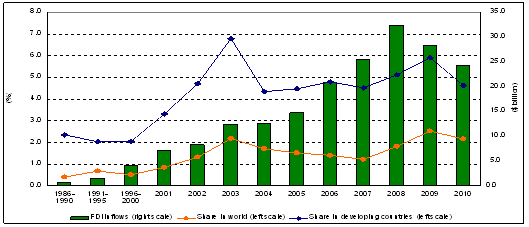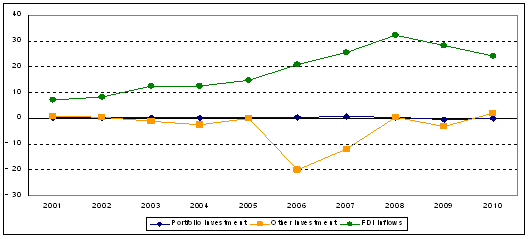| EMBARGO The contents of this press release and the related Report must not be quoted or summarized in the print, broadcast or electronic media before 2 May 2011,17:00 [GMT] |
Although investment in the least developed countries has climbed, the study says, it has limited impact on jobs, living standards
Geneva, 2 May 2011 - A new UNCTAD report on the status of foreign direct investment (FDI) in the world´s 48 poorest countries urges a changed approach that would focus such investment on creating jobs, as well as on enhancing those countries´ productive capacities - that is, their abilities to produce wider varieties of goods and more sophisticated goods.
The report, titled Foreign Direct Investment in Least Developed Countries: Lessons Learned from the Decade 2001-2010 and the Way Forward, is intended to contribute to debate at the Fourth United Nations Conference on the Least Developed Countries (LDCs) next week in Istanbul.
It notes that while FDI to these nations grew rapidly over the decade to reach an estimated $24 billion in 2010 and their share of global foreign investment flows has effectively doubled to 2%, most in terms of value was dedicated to natural-resource extraction. That sector has tended to create relatively few jobs, the study says. Such investment also has not tended to "fertilize" LDC economies by leading to greater links between foreign businesses and local firms that can spread know-how and technology and help spur broad-based, long-term economic growth. Although FDI has recently enabled some LDCs to connect with the global value chain in which products are upgraded and reap higher profits, the majority of LDCs remain marginalized from the world economy, the report says.
Among other things, the study recommends the establishment of an "LDC infrastructure development fund" that would improve these countries´ abilities to attract investment by upgrading such factors as electricity supply, roads, railroads and computer or Internet connections. Such a fund would seek to provide "innovative" solutions to infrastructure weaknesses by establishing public-private partnerships between LDCs and foreign investors.
It also calls for an aid-for-productive-capacities programme that would support technical and vocational training, education and entrepreneurship in LDCs. The intent is to provide LDC populations with skills that can attract foreign investment and spur sustainable economic progress.
The report recommends that LDC governments and overseas development partners boost efforts to attract small- and medium-scale international investors - a group that often finds and exploits hidden business opportunities. It says that LDC governments should develop strategies and provide incentives to target opportunities where investors can use technology to "leapfrog," as is already happening in telecommunications with the rapid development of mobile telecommunication networks and with ancillary services such as mobile phone banking or payment services in rural areas.
There is a potential for business people to get involved further in investment by undertaking projects that aim to solve social and environmental challenges, the study says.
The report also calls for governments to implement regulatory reforms that can help channel FDI in directions that should act to improve living standards, create jobs and broaden the economic bases of LDCs.
The report features detailed FDI-related data on all 48 LDCs. It contains annexes and aggregate data on FDI trends.
ANNEX
Tables and figures
FDI inflows to LDCs and their share in world inflows and developing-country inflows, 1986-2010
(billions of dollars and percentage)
Source: UNCTAD, FDI/TNC database (www.unctad.org/fdistatistics ).
Note:Data for 2010 are estimates.
Private capital flows to LDCs, 2001-2010
(billions of dollars)
Source:UNCTAD, FDI/TNC database (www.unctad.org/fdistatistics ) (for FDI inflows) and IMF (for portfolio and other investments).
Note:Data for 2010 are estimates. Other investment includes mainly bank lending.


